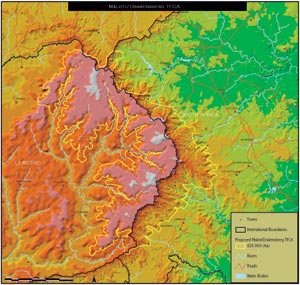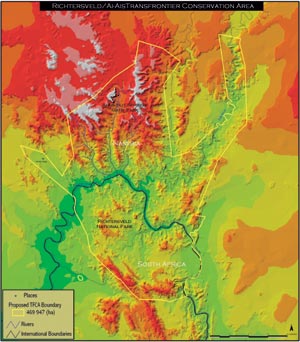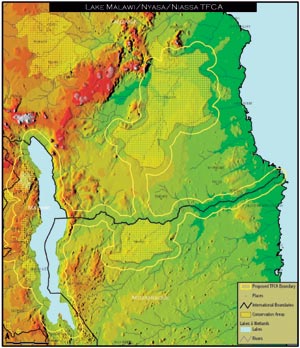The Peace Parks Foundation Aided by GIS
The Peace Parks Foundation (PPF) is a nonprofit organization with a mission to  facilitate the establishment of Transfrontier Conservation Areas (TFCAs) in the Southern African Development Community supporting sustainable economic development, the conservation of biodiversity, and regional peace and stability.
facilitate the establishment of Transfrontier Conservation Areas (TFCAs) in the Southern African Development Community supporting sustainable economic development, the conservation of biodiversity, and regional peace and stability.
"Peace Parks offer a vision for the future of Africa that is practical, realistic, and attainable," says Dr. Anton Rupert, chairman, PPF. "People will benefit and wildlife sanctuaries will be joined together in a continuum bequeathing future generations with a priceless asset. The promotion of an associated culture of peace should be welcomed by all. It is long overdue."
The vision of the PPF is to develop a network of TFCAs by unifying fragmented ecological habitats and promoting environmental and political stability in Africa. To do  this, a unique level of international cooperation between the participating countries is needed, particularly on sensitive issues such as the opening of international boundaries and cross-border management of the parks; thus, support from top political levels is necessary.
this, a unique level of international cooperation between the participating countries is needed, particularly on sensitive issues such as the opening of international boundaries and cross-border management of the parks; thus, support from top political levels is necessary.
Left: Digital terrain model of the Lesotho Highlands and escarpment of the proposed Maloti/Drakensberg TFCA.
Another important requirement is an effective GIS to moderate the planning and facilitate the monitoring of each TFCA with its own specific requirements. As a result, the PPF has established an internal GIS laboratory. It is felt that the development and management of TFCAs without the use of this technology would be extremely difficult if not impossible.
PPF is working with Esri and Geographic Information Management Systems (GIMS), Esri's South African distributor, both of whom have included the PPF within their conservation programs. Using ArcView GIS with its extensions ArcView 3D Analyst and ArcView Spatial Analyst, PPF has delineated probable park boundaries and zoning plans for some of the TFCAs to move the facilitation process forward. The zoning of each proposed park takes into account the boundaries of environmental features. These boundaries include  ecological, aesthetic, and land use characteristics. Normally catchment basins, landscape types, vegetation, or land cover are the most suitable. Watersheds are both aesthetically and ecologically important and landscape boundaries are slope and geomorphologically related. Land cover is often the most important indication of vegetation condition, showing where undisturbed plant communities remain. A combination of these features captured in ArcView GIS is used to arrive at the proposed zoning plans for the various TFCAs.
ecological, aesthetic, and land use characteristics. Normally catchment basins, landscape types, vegetation, or land cover are the most suitable. Watersheds are both aesthetically and ecologically important and landscape boundaries are slope and geomorphologically related. Land cover is often the most important indication of vegetation condition, showing where undisturbed plant communities remain. A combination of these features captured in ArcView GIS is used to arrive at the proposed zoning plans for the various TFCAs.
Right: Digital terrain model of the topographical features of the proposed Richtersveld/Ai-Ais TFCA.
ArcView GIS is crucial to the analysis and planning of the TFCAs and has been used to capture and analyze data from the conservation area known as Coutada 16 in Mozambique. To effectively zone the region for the proposed tourism land use plan, all features deemed significant in terms of land use were assigned values after consultation with experts in the field, and the attributes of each feature were weighted accordingly. From these, through a series of map calculations using ArcView with various extensions and the input of expert advice, information was derived as to which areas are suitable for the zoning of a specific activity or land use.
In planning and monitoring any TFCA, it is essential to have up-to-date information on land use, settlement patterns, vegetation, soils, geology infrastructure, and population density. Satellite imagery, heads-up digitizing, and field surveys are used to effectively derive the data that is required during the planning of a TFCA. A land cover data set was purchased from Mozambique's National Directorate of Geography and Cadastre (DINAGECA). Landsat 7 images were purchased from the United States Geological Survey (USGS) and with manipulation in ERDAS IMAGINE the images were used to derive vegetation indexes.
Not all the required data was available in soft-copy format. Vegetation and geology data was obtained in hard-copy format (paper maps). The necessary South African data, data specifically applicable to this project, was extracted from the Environmental Protection Atlas data series. By integrating this data, a land use zoning plan was  derived and presented to the Ministers of Environment and Natural Resources, who approved it in February 2001. With not only the spatial component visually enhanced but with improved analysis of spatial data, as well, the Gaza/Kruger/Gonarezhou TFCA region facilitation, management, and marketing have thus far been greatly assisted. At present there are many TFCA projects in various stages of development.
derived and presented to the Ministers of Environment and Natural Resources, who approved it in February 2001. With not only the spatial component visually enhanced but with improved analysis of spatial data, as well, the Gaza/Kruger/Gonarezhou TFCA region facilitation, management, and marketing have thus far been greatly assisted. At present there are many TFCA projects in various stages of development.
Left: Digital terrain model of the proposed Lake Malawi/Nyasa/Niassa TFCA.
"Information is the foundation for any decision," says Professor Willem van Riet, executive director, PPF. "Now TFCA facilitators and planners will have detailed information at their disposal."
Combined with Visual Basic, MapObjects LT software was used to produce a customized viewer. This application is being used to disseminate and display spatial information to key role players. The viewer allows for non-GIS people associated with the implementation and management of TFCAs to access this spatial information.
The foundation is managed by a board of directors under the chairmanship of Dr. Anton Rupert and the executive directorship of Professor Willem van Riet, and has seven honorary patrons, Nelson Mandela being the patron emeritus.
For more information, contact Craig Beech, Peace Parks Foundation GIS, Stellenbosch, South Africa (tel.: 27-0-21-8876188, e-mail: cbeech@ppf.org.za).
